
NORTH CAROLINA COAST – There have been six drownings on the coast so far this year.
Emerald Isle Police Chief Tony Reese said that this is the earliest they’ve seen any type of water rescues or drownings in the 20 years he’s been at the town. Usually, the water temperature this time of year is still in the 60s, and people typically don’t go into the ocean.
Supporter Spotlight
But it’s not the cold putting lives in danger. It’s rip currents.
If a visitor were to find themselves in a rip current, Atlantic Beach Fire Chief Mike Simpson said, “The best thing to do is remain calm and float. Panic and fatigue are the reason for most rip current drownings. Swimming parallel to the shore will eventually get you out of the rip current as most rip currents are only 10-20 feet wide. Signal for help, remain calm and try to float.”
Dave Baker, ocean rescue director and firefighter for Wrightsville Beach, explained that the rip currents, “do not pull you under, they pull you out,” which is why it’s important to remain calm and swim parallel to the shore.
Pine Knoll Shores Fire Chief Jason Baker recognized that it is hard not to panic. “Being caught in a rip is scary but if you panic you die, no question. People panic and they fight the rip, this expends energy and energy is your ability to stay afloat, if you tire out, you cannot keep yourself afloat.”
Reese added there have been many situations where panic has caused someone caught in a rip current to over exert themselves and go into cardiac arrest, leading to their death.
Supporter Spotlight
In addition to having your own flotation device when swimming, Reese said that you should never attempt a rescue without one. The town has about 100 for use at nearly every beach access in Emerald Isle. If you get close enough to the person and don’t have a flotation device, he warned, “You’re going to become the flotation device. But first, if you see someone in the water, call 911 before you do anything else and get rescue personnel on the way.”
If calling 911, it is imperative that you know your location, be it a beach access or approximate distance from a fixed location such as pier, restaurant or hotel, Dave Baker said. “That way help has a greater chance of responding in a timely manner and not wonder where on the beach strand you are located.”
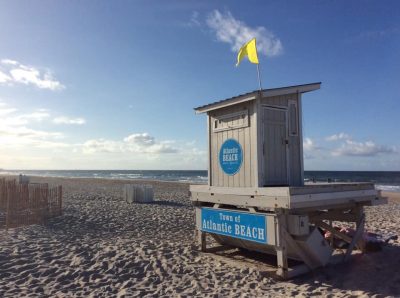
Many beach towns and the National Park Service are working to keep beachgoers aware of the dangers of rip currents by using warning flag systems, having lifeguards both stationed on and patrolling the beaches from Memorial Day weekend to Labor Day weekend and using various avenues to inform the public about the dangers of rip currents.
Reese advised that before heading into the ocean, understand the risks.
“If you’re going to take a vacation in the desert, I’m sure you’d sit down and do research about what to be aware of and to look for, coming to the ocean is no different. People need to do their research and understand surf conditions,” he said.
Mike Barber, public information officer for Cape Hatteras National Seashore, said the same. “It is very important for seashore visitors to check the daily beach forecast and learn about ocean hazards before heading to the beach.”
Reese explained that the Emerald Isle Fire Department evaluates the beach conditions every morning and shares their observations with the National Oceanic and Atmospheric Administration. “We base our forecast and flag on what we’re seeing on our beaches.”
Pine Knoll Shores Fire Chief Jason Baker said you can also use your smartphone to check the weather and NOAA’s rip current forecast before even leaving for the beach.
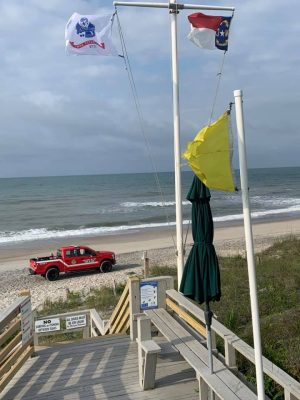
“There are dozens of weather apps that can give you the forecast where you will be vacationing. NOAA puts out a rip current forecast every day, look at it and see what they are predicting,” he said.
Pine Knoll Shores, like many beach communities, uses green, yellow and red warning flags. Jason Baker said to think of the colors used for the flags like traffic stop lights.
“Green means go, yellow means caution, red means stop. Here in Pine Knoll Shores, we also fly a black flag for closure of the water. You can go to the Pine Knoll Shores Fire and EMS Facebook page and check what flag we are flying that day as well as a synopsis of what the flag colors mean,” Jason Baker said.
If you have questions, call the fire department and ask what they think of the beach conditions that day. “They are the ones who perform the rescues, they study the weather conditions, and they have a good ‘feel’ about how dangerous the conditions are,” Jason Baker said. The town also shares conditions via social media, at paid parking accesses and the police department patrols the beach four times a day to speak with beachgoers.
Visitors should first look to see if there are lifeguarded areas for swimming and heed beach warning flags and any posted informational signs, Simpson said, and to either wear a flotation device or have some form with them, such as a boogie board. He also reminded visitors to “never let small children out of their sight or in the water alone.”
The warning flag system in Atlantic Beach is also green, yellow and red, with green meaning low hazard, yellow medium hazard and red being high hazard.
“Yellow or red beach warning flags are used at many beach accesses throughout Atlantic Beach,” Simpson said, adding if rip current risks are low, there will be a green flag at the main lifeguarded beach area, which is at the “Circle” beach.
Starting Friday through Labor Day, Lifeguards will begin patrolling the beach from the three towers and two lifeguards will be out on ATVs Friday-Sunday on either end of the main beach strand.
Simpson added that the fire department checks beach conditions at 9 a.m. and between 4 and 5 p.m. daily and posts warning flags accordingly. The police department has increased beach patrols to several times daily to be able to educate and warn beach visitors of the dangers of rip currents.
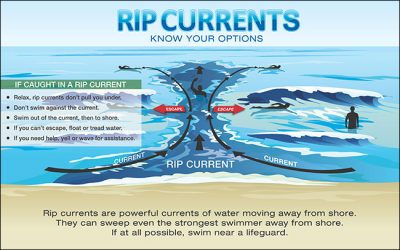
Reese told Coastal Review Online that Emerald Isle never flies green flags on its 13 miles of beach, which is half of the 26-mile Bogue Banks, because they don’t consider the ocean to ever be completely calm and safe.
“There are always currents, always hazards if you enter the ocean,” Reese explained. “The lowest level of flag we fly is a yellow flag, that is a moderate risk. For high risk, we’ve always flown the red flag.” If you don’t see flags on the beach between Memorial Day and Labor Day, then you can assume yellow-flag conditions.
Emerald Isle flies warning flags at public accesses, at both town welcome signs, both fire departments, at lifeguard stands at the Western and Eastern ocean regional accesses, which have lifeguards starting Memorial Day weekend, on the vehicles of the four lifeguards that patrol the beach as well as the Public Works vehicles that drive on the beach to empty the trash cans. The attendant at the paid parking lots can also provide information.
The town tries to educate beachgoers as soon as they check into their vacation home by providing a flier for real estate companies to distribute to renters, the Parks and Recreation Department hands out drink koozies with flag information and what to do if in a rip current, created an FAQ, and the police department is offering classes 6 p.m. June 3, 10 a.m. June 18 and 6 p.m. June 25 on Beach and Ocean Safety, all in the meeting room of the police department. Emerald Isle also has for loan approved flotation devices for children at the lifeguard stands.
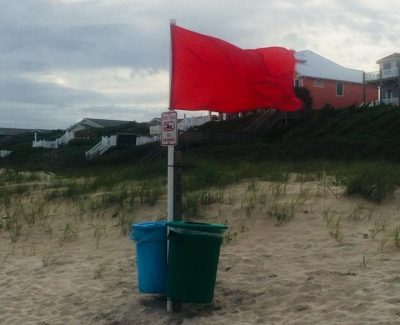
“Up until recently, we had a lot of success of people paying attention to the flag,” Reese said. “But here lately, that doesn’t seem to be working.”
Last year in the span of 11 days, there were 105 water rescues. In total for 2018, Emerald Isle Fire and Rescue lifeguards conducted 8,526 preventative lifeguard interventions, 433 welfare checks of swimmers and 319 successful water rescues.
“Our goal has always been voluntary compliance,” Reese said. “We’ve had some issues as of late moving us toward fines and why we started flying double red flags this year.”
An ordinance was adopted in 2014 that allows the town manager to close the beach under certain conditions. Emerald Isle decided to use the double red flag this year to indicate that the town manager closed the beach to swimming. “If you’re found in the water you can be cited or arrested for violation of the ordinance,” Reese said.
The measure was taken because not only is the person in the water putting themselves at risk when they were warned not to go in the ocean, but they’re also putting first responders and other beachgoers who may attempt to save the swimmer at risk.
The town posts the red and double red flags about every 200 yards along the beach when there are dangerous rip currents. Reese said it takes about six hours for the 18 seasonal lifeguards, public works, police and fire departments to put out the 125 flags. “If we’re under red or double red, from Memorial Day to Labor Day, it’s impossible for you not to see those flags.”
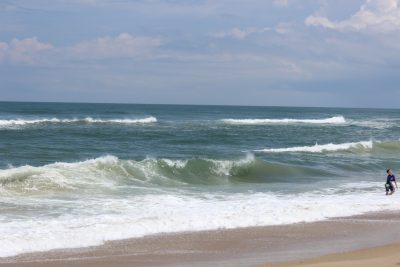
Dave Baker with Wrightsville Beach recommended swimming in front a lifeguard for a better chance of surviving any incident in the water. But when in doubt about the conditions, stay out of the water.
Wrightsville Beach lifeguards, which go through a two-week training period when they receive more than 60 hours of medical training, including CPR, first aid and advanced trauma, and U.S. Lifesaving Association training, staff 13 lifeguard stations from 10 a.m. to 5 p.m. seven days a week. Dave Baker said Wrightsville Beach also uses the green, yellow and red flag warning system, which he said is found at most North Carolina beaches.
Cape Hatteras National Seashore visitors can find out the daily beach forecast and ocean safety information on its website, Facebook and Twitter or from a ranger during programs at Cape Hatteras National Seashore, Fort Raleigh National Historic Site and Wright Brothers National Memorial.
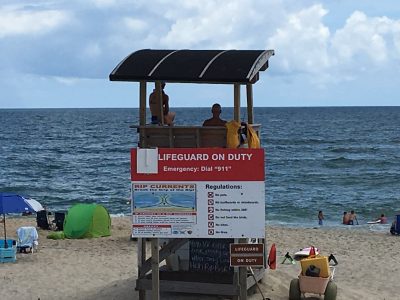
From 9 a.m. to 5 p.m. Memorial Day weekend through Labor Day, lifeguards will be at Coquina Beach Access on Bodie Island, Ocracoke Beach Access, Cape Hatteras Lighthouse Beach Access and new this year, at the Frisco Beach Access, both at Hatteras Island.
The seashore has partnered with Dare County and other agencies on a safety awareness campaign, Love The Beach, Respect The Ocean. Text “Join OBXBeachConditions” to 30890 for text alerts on conditions and use the #LoveTheBeachRespectTheOcean hashtag on social media.
Hatteras Island Rescue Squad posts daily ocean reports on Facebook and will begin May 27 beach patrols in Avon, Buxton, Frisco and Hatteras villages. The rescue squad at 9:30 a.m. Monday, May 27, will hold its first Rip Currents and Beach Hazards education class of the year at Station 35, 48103 N.C. 12. Classes are held at 9:30 a.m. every Monday through the season.
In addition to rip currents, Reese said beachgoers need to be just as concerned about lightning and storms, sea creatures, sting rays, Portuguese men-of-war and jelly fish. Emerald Isle posts a purple flag if there is an abundance of hazardous wildlife.
Dave Baker with Wrightsville Beach reminded beach visitors to leave the beach better than the found it. “If you see trash, pick it up, if you have trash, pack it out.” To be safe, do not dig holes more than waist deep of the shortest person because “If the sand compresses on the person, then they can’t breathe,” and refill the hole when you leave for both visitor and turtle safety. Also, don’t forget to wear sunblock. “Remember the top of your feet and tips of your ears.”
Pine Knoll Shores Fire Chief Jason Baker reminds visitors there is no level of swimmer that is safe from the dangers of the ocean.
“With that in mind I ask everyone visiting to the beach this summer to come on down and have a great day on the beach, but please be respectful of the ocean when venturing out,” he said. “Pay attention to what the conditions are, what flags are flying and if you have any doubt call the local fire department and ask the duty crew their thoughts.”








